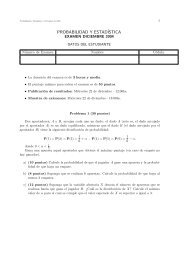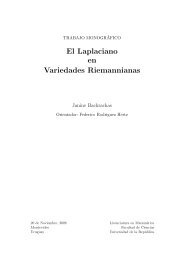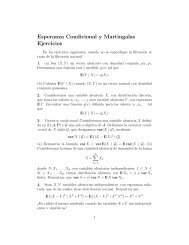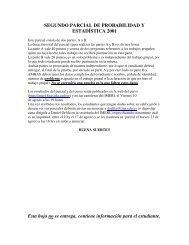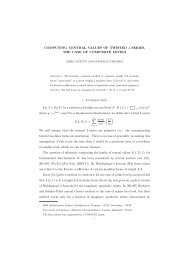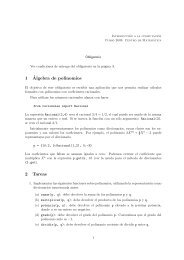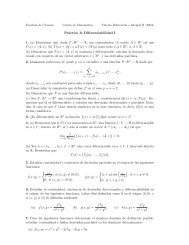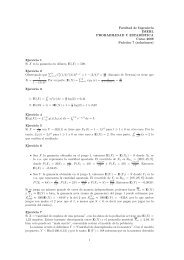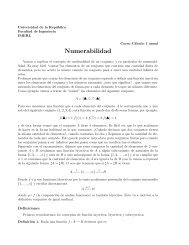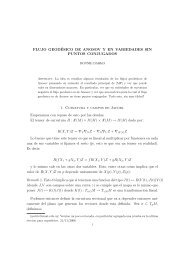CapÃtulos 6 y 7 de Petrov. V.V, Mordecki, E. TeorÃa de la ...
CapÃtulos 6 y 7 de Petrov. V.V, Mordecki, E. TeorÃa de la ...
CapÃtulos 6 y 7 de Petrov. V.V, Mordecki, E. TeorÃa de la ...
Create successful ePaper yourself
Turn your PDF publications into a flip-book with our unique Google optimized e-Paper software.
24 Capítulo 7. Teorema central <strong>de</strong>l límiteentes e idénticamente distribuidas, con esperanza matemática E X 1 = a yvarianza var X 1 = σ 2 > 0. DesignemosEntonces,( X1 + · · · + X n − naF n (x) = Pσ √ n)≤ x .F n (x) → Φ(x) (n → ∞) para todo x real, (7.1)don<strong>de</strong> Φ(x) = 1 √2π∫ x−∞ e−t2 /2 dt es <strong>la</strong> distribución normal estándar.Demostración. La primer etapa consiste en <strong>de</strong>mostrar el teorema en elcaso particu<strong>la</strong>r en el que E X 1 = a = 0 y var X 1 = σ 2 = 1.Consi<strong>de</strong>remos entonces para cada n = 1, 2, . . . <strong>la</strong> variable aleatoriaZ n = 1 √ n(X1 + · · · + X n).Como a = 0 y σ 2 = 1, tenemos P(Z n ≤ x) = F n (x). La <strong>de</strong>mostraciónse basa en <strong>la</strong> aplicación <strong>de</strong>l teorema 6.5. Calculemos f n (t), <strong>la</strong> funcióncaracterística <strong>de</strong> Z n , en términos <strong>de</strong> v(t), <strong>la</strong> función característica <strong>de</strong> X 1 :f n (t) = E e itZn = E e i(t/√ n) P nk=1 X k= E=n∏E e i(t/√ n)X k=k=1n∏k=1e i(t/√ n)X k[ ( t)] n,v √ (7.2)ndon<strong>de</strong> utilizamos que <strong>la</strong>s variables aleatorias son idénticamente distribuidasen <strong>la</strong> última igualdad, y que son in<strong>de</strong>pendientes en <strong>la</strong> ante última.Como α 2 = var X 1 = 1 < ∞, aplicando el <strong>de</strong>sarrollo <strong>de</strong> Taylor (6.10) <strong>de</strong>or<strong>de</strong>n k = 2 para <strong>la</strong> función característica <strong>de</strong> X 1 , tenemosv(u) = 1 − u22 + o(u2 ) (u → 0), (7.3)dado que α 1 = E X 1 = 0. Consi<strong>de</strong>remos un real t arbitrario y fijo. Queremoscalcu<strong>la</strong>r lím n→∞ f n (t). Si en (7.3) ponemos u = t/ √ n, tenemos( t)(v √ = 1 − t2 1)n 2n + o ndado que 1/n → 0 si y solo si u → 0.(n → ∞),



